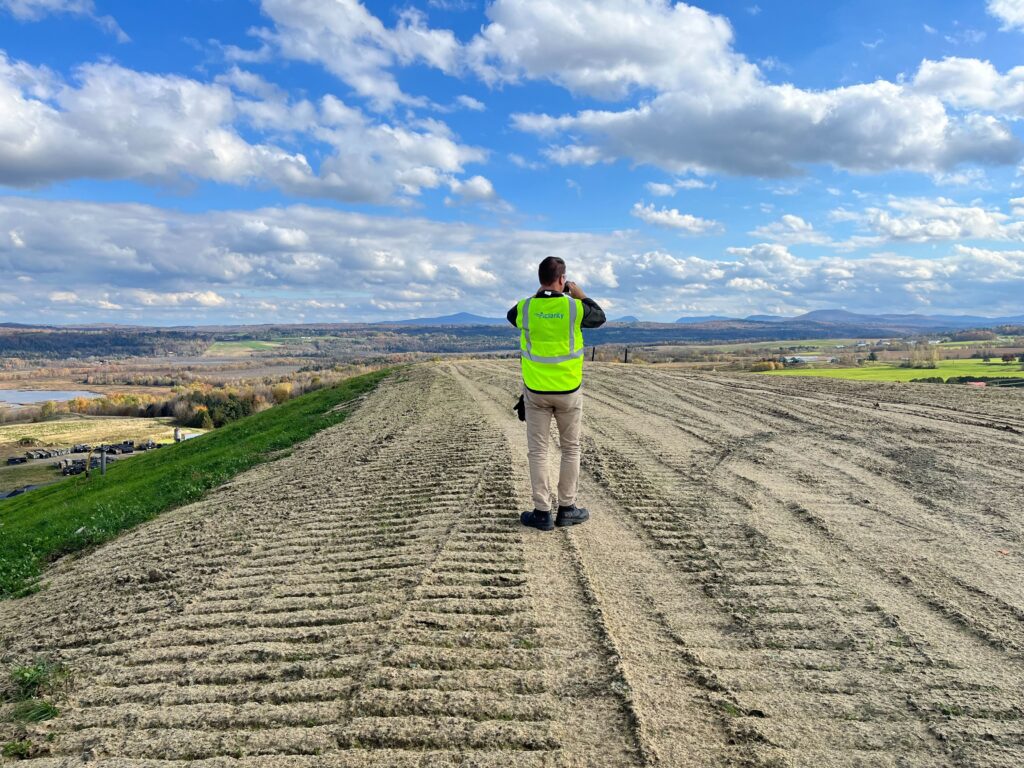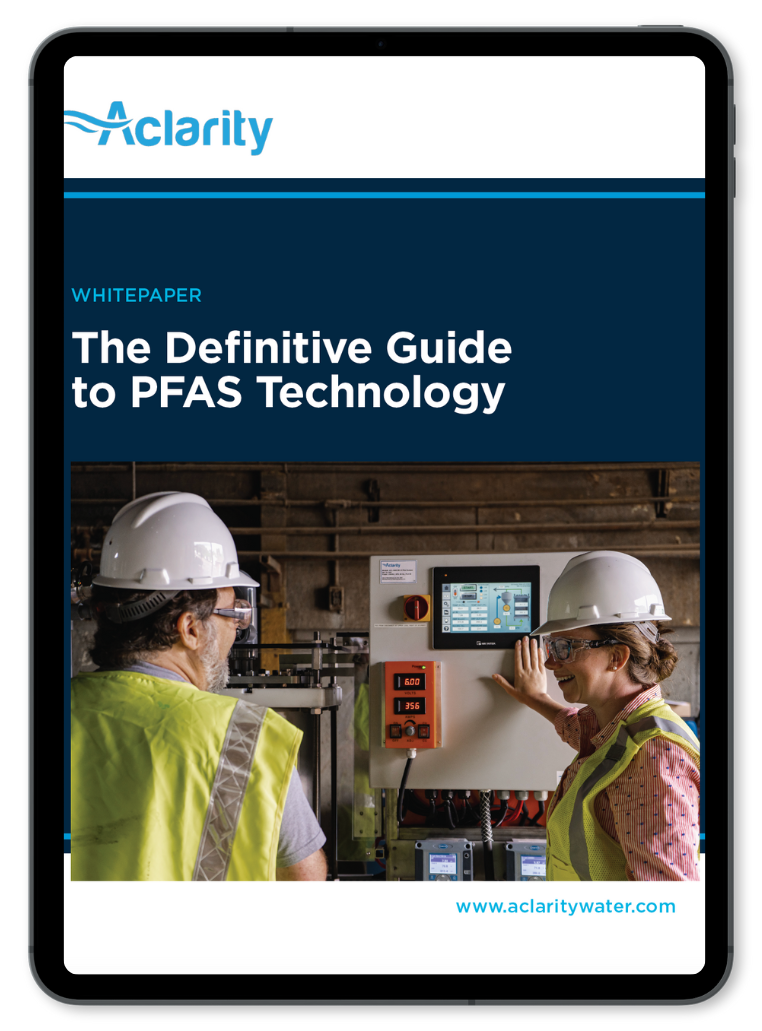PFAS Water Treatment : A Guide
September 17, 2024 | 5 minute read

Introduction
When it comes to Per-and polyfluoroalkyl substances (PFAS) there are growing concerns as to the impact these chemicals are having on us. In part, due to increased health concerns, but also given how ubiquitous they are, and how they’ve made their way into our food, our water and our homes.
This article focuses on PFAS in water and specifically explores the three dominant approaches emerging that enable companies to manage and treat PFAS in wastewater.
But first a definition.
What is PFAS?
PFAS refers to a body of ‘forever chemicals’ that first emerged in the late 1930s and 1940s, before being developed commercially in the post-WWII era. Their use accelerated in the 1950s and 1960s in part due to the particularly attractive properties of these chemicals, but also the sheer range of applications PFAS featured in: from cookware to food packaging to clothing.
In the 1970s and 80s studies first began to emerge which tied them to potential health risks. However, it is only in recent years that they’ve entered the public consciousness as more evidence has come to light, as to the dangers associated with them. An inherent issue with PFAS is that what makes them so attractive is also a double-edged sword. They do not break down easily, and much like challenges with plastic waste, the twin combination of breadth of use/ popularity and robustness means it is a real challenge to deal with PFAS. In short, what made them so attractive for manufacturers, is what makes them so difficult to deal with, when tasked with treating them.
So how to tackle PFAS?
For a start, the EPA has been leading the charge in increasing regulations pertaining to their use. Upstream, manufacturers are subject to much more stringent regulations, targeting those who traditionally used PFAS to enhance fabric durability, as well as to improve its resistance to water (and stains). As mentioned previously the sheer breadth of use means a whole swathe of manufacturers are caught in the net.
“The 3M Company announced that it would discontinue the use of per- and polyfluoroalkyl substances (PFAS) across its product portfolio and exit PFAS manufacturing by the end of 2025.
The company says that its decision was based on many factors, including changing stakeholder expectations and accelerating regulatory trends focused on reducing the presence of PFAS in the environment.” (Source: Water World)
The risks of fines are one deterrent, but similarly, as public awareness grows an increasing number of manufacturers are looking to get ahead of the curve by eliminating PFAS from production lines. After all, the direction of travel is clear, and history will remind them that complex supply chains mean it is better to tackle the issue early.
Downstream, landfill operators are subject to an increasing array of state and EPA lead regulations, alongside the threat of regulation from local communities. By way of an example, the 2019 movie Dark Waters (available on Netflix), starring Mark Ruffalo, as Rob Bilott, a partner at Taft Law offers an excellent insight into the challenges at hand.
With a growing number of PFAS regulations affecting water suppliers, it is crucial for utilities to understand the ways they can treat these contaminants affordably. Managers and operators at water utilities must educate themselves on PFAS, build trust with their communities, and juggle evolving regulations — all while simultaneously planning for and funding new treatment systems. As such, PFAS treatment and remediation costs are a dominant topic at U.S. water and environmental conferences, as well as amongst regulators, utilities, academics, and environmental and public health advocates.
(Source: Water World)

The Definitive Guide to PFAS Technology Whitepaper
Comprehensive guide to understanding PFAS management strategies to reduce risk and safeguard environmental and public health.
Stay current on advantages and disadvantages of technologies available for PFAS:
- Removal
- Disposal
- Destruction
Landfill Operators
In some ways, landfill operators are suffering the brunt of the pain, as they need to modify waste acceptance policies, have to ensure regulatory compliance, and incur additional operational and legal costs to mitigate against PFAS-related issues. Landfill leachate increasingly contains high levels of PFAS and thus they are front and center when it comes to PFAS management. So what are some of their options for those tasked with needing to treat PFAS-contaminated water or leachate?
PFAS in Water (Industrial)
Many water agencies have already begun to address PFAS in their water supplies. PFAS treatment solutions include granular activated carbon adsorption, ion exchange resins as well as nano-filtration and low-pressure reverse osmosis membrane treatment processes. (Source: Water World)
Before we jump in, it is worth restating that this article is not tackling PFAS in domestic water e.g. from a household tap. However, it will assist water companies upstream that may face PFAS-related issues in the years to come.PFAS are now found everywhere in the environment. They contaminate surface- and groundwater, including drinking water; in the EU, 65% of the drinking water is derived from groundwater. Source: European Environment Agency
Removing PFAS from Water
The United States Environmental Protection Agency (USEPA) Drinking Water Treatability Database outlines some effective technologies for reducing PFAS in drinking water. These include activated carbon adsorption, ion exchange resins and high-pressure membranes, such as nanofiltration or reverse osmosis, and these represent three approaches gaining popularity when it comes to PFAS water treatment. It provides users—including drinking water utilities, primacy agencies, first responders to spills or emergencies, treatment process designers, research organizations, academicians, and others—with current information on more than 30 treatment processes and over 120 regulated and unregulated contaminants, including 26 PFAS chemicals.
Source: The Drinking Water Treatability Database
1- Granular Activated Carbon Absorption (GAC)
The GAC approach leverages porous carbon materials and is designed to absorb PFAS from water as it passes through a bed of activated carbon (the PFAS molecules are attracted to the carbon surface and bind to it).
2- Membrane Separation
Reverse osmosis and nanofiltration both utilize membranes to remove PFAS from liquid solutions. These membrane treatment processes apply pressure to the more concentrated solution, forcing the water through the membrane and removing PFAS in the process.
Of course there are Pros and Cons to all approaches, and it is important to assess the various methods in terms of efficacy, costs, and any residuals. Again the EPA’s Drinking Water Treatability Database does a really good job of helping you navigate the range of options.
What Happens After Removal?
The stated removal method above all require a disposal or destruction method afterwards. With removal and disposal often being things like solidifying PFAS, encapsulating it and putting it back into a landfill or incineration (leading to questions about air quality/safety) one must look to methods that end the PFAS cycle, such as PFAS destruction technologies. (Link)
PFAS Water Treatment and Aclarity
Aclarity’s on-site electrochemical oxidation system destroys PFAS, ammonia, BOD, COD and more. Because of its on-site capability, destruction reduces the need to engage in removal and disposal efforts (including off site hauling). PFAS destruction technologies like Aclarity typically offer a site test so you can quickly gauge the power of its electrochemical oxidation (EOx) system and zero in on how it can help your facility.
Summary
One of the key historical challenges with PFAS remediation is that some early solutions were akin to the game of “kicking the ball down the road” where the problem was transported, buried or burned - in short creating additional issues elsewhere. In more recent years the focus on PFAS innovation has been to help tackle the issue in situ and without creating additional externalities. Disposal has been replaced by destruction as Leanne Hersey, Vice President of Marketing at Aclarity argues “Removal offers partial respite, but destruction is a comprehensive solution and the only clear path to a future that does not include PFAS.”
“A key component of any destructive technology is that the solution must not simply transfer the PFAS problem from one element of the environment to another (soil to air, water to wastewater, water to landfills, etc.). Therefore, the push to identify, develop, and implement effective and affordable destructive technologies that eliminate PFAS from the environment altogether is essential to overall public health”. (Source: Water World)
Nature is better off without PFAS. And so is your business.

The future of waste management starts now. Destruction beats disposal so we created an on-site solution that puts an end to PFAS for good. When our EOx process meets forever chemicals, the environment is not the only winner. Get a free evaluation for your PFAS destruction needs today.

